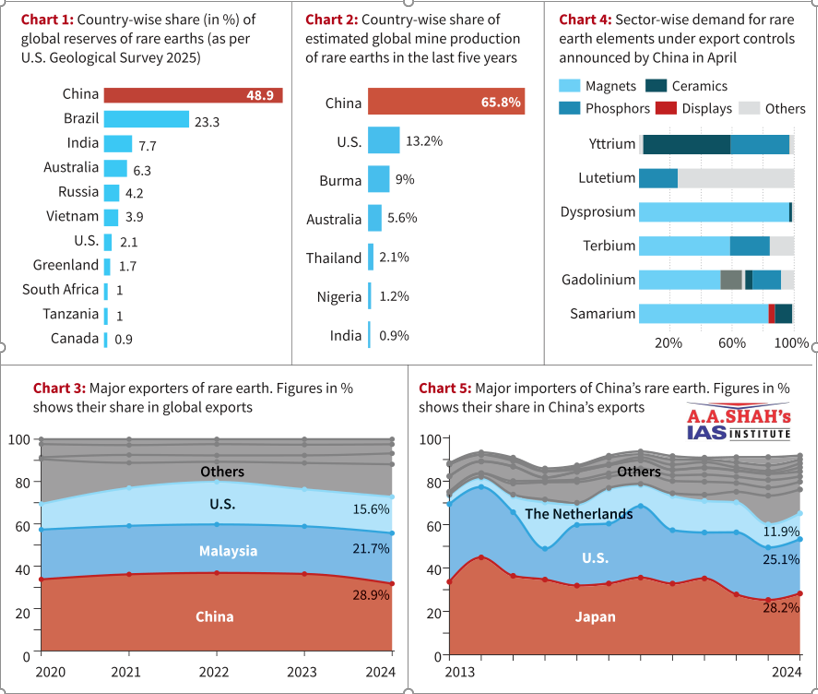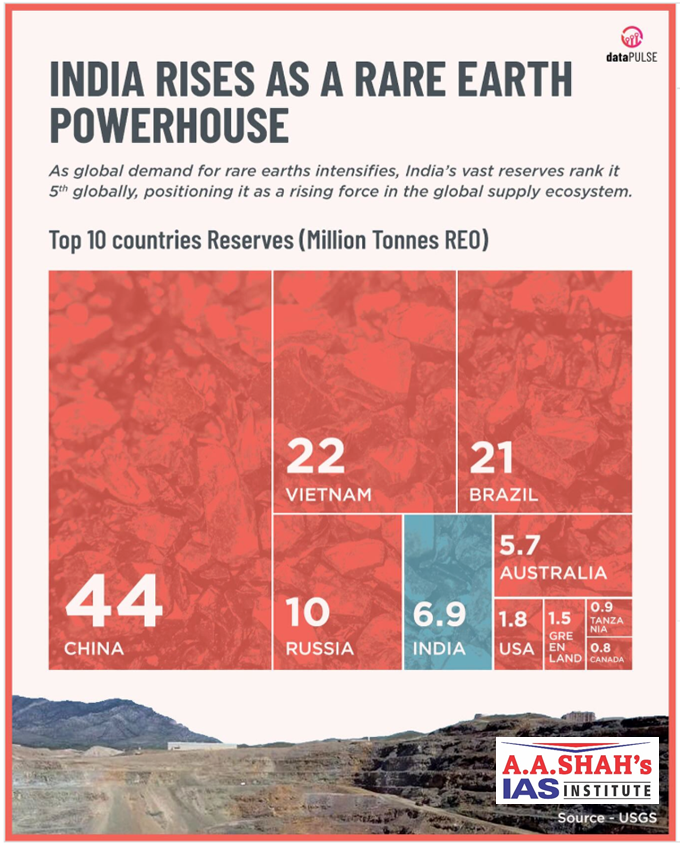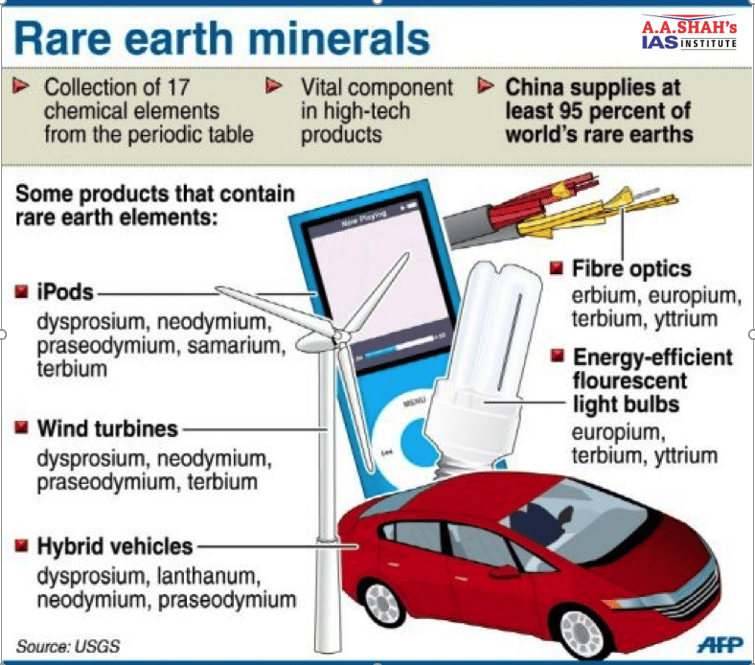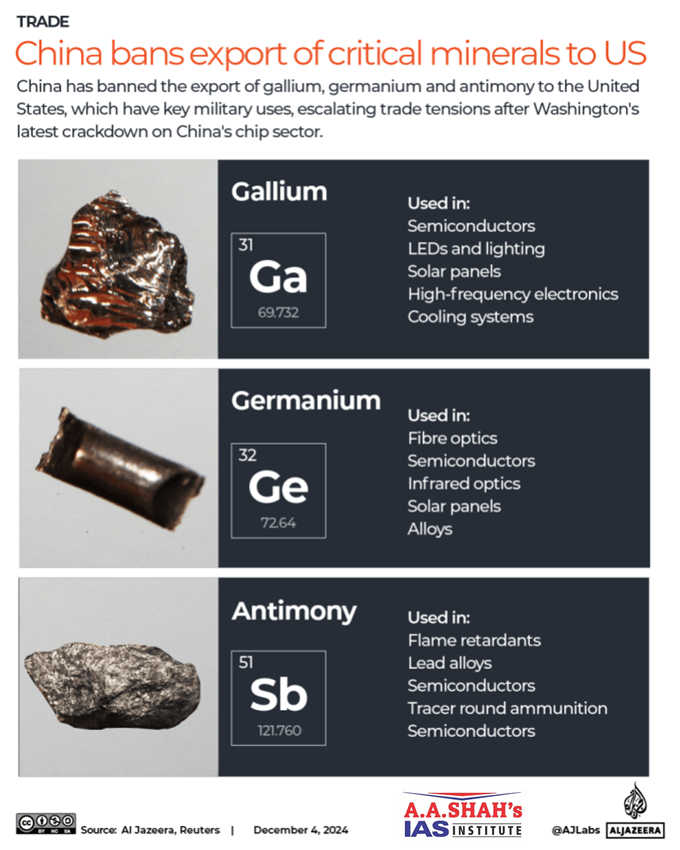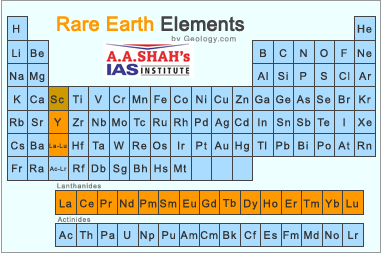China digs in on ‘rare earth’, commands global market
GEOGRAPHY – RESOURCES
10 SEPTEMBER 2025
What are Rare Earth Minerals?
- According to the International Energy Agency (IEA), Rare Eearth Elements comprise 17 metals, in Group 3 of the Periodic Table comprising Lanthanide series, typically grouped into light rare earths (LREEs) — including lanthanum, cerium, praseodymium, neodymium, samarium and europium — and heavy rare earths (HREEs) such as gadolinium, terbium, dysprosium, holmium, erbium, thulium, ytterbium, lutetium, scandium and yttrium.
- Promethium is not included in the list as it is radioactive and does not occur in mineable quantities.
Uses of Rare Earth Minerals
- Rare earths are critical components in clean energy technologies such as electric vehicles (EVs) and wind turbines, as well as in military applications such as missiles and radar systems.
- Rare earths are also essential for high-tech devices including smartphones and hard drives.
- Rare earth elements such as europium, terbium, and yttrium are integral in the production of phosphors used in display technologies. These phosphors emit specific colours when excited by electrons, enabling the vivid displays in flat-screen televisions and computer monitors.
- Neodymium–iron–boron (NdFeB) magnets are essential for clean energy technologies — as well as those critical to ceramics, phosphors, steel, optical glass, fibres, and aerospace applications.
- Rare earths or the magnets which they are sometimes made into can be found in small but important quantities in everything from iPhones and washing machines to the F35 fighterjet.
- Without them, supply chains quickly grind to a halt.
- Automakers were forced to paused some production earlier in 2025 after Chinese export controls caused shortages.
Why called Rare earth ?
- Rare earth minerals are moderately abundant in nature but not concentrated enough to make them economically exploitable.
- Rare earth elements (REEs), despite the name, are not rare in the sense that they are uncommon; some are more common than lead, for example.
- But they tend to be spread thin around the Earth’s crust in small quantities and mixed together or with other minerals.
China’s dominance
- Although rare earth deposits exist in countries such as Brazil, Australia, and India, China holds nearly half of global reserves.
- It is also the world’s largest producer, contributing over 60% of global production in the last five years.
- Beyond extraction, China dominates the value chain with around 92% of global refining capacity.
- Moreover, in the last five years, China has been the largest exporter, supplying close to 30% of global demand.
India and Rare Earths
- India has the third-largest rare earth resource globally, with mainly concentrated in its monazite minerals.
- Monazite is a radioactive atomic mineral used for the production of Thorium (as high as 500 ppm) and has the potential to be used as fuel in the nuclear power system.
- The major monazite reserves are concentrated in Tamil Nadu, Kerala, Andhra Pradesh, Odisha, and Maharashtra.
- India, too, is heavily dependent on China for its rare earth imports. Since 2021, more than 75% have come from China.
- Rare earth minerals are also present on the seafloor, particularly in international waters beyond national jurisdictions.
Environment Impact
- Processing rare earths often involves the use of solvents, which can produce toxic waste that pollutes the soil, water, and atmosphere.
- Certain types of rare earth ores also contain radioactive thorium or uranium, which is often removed using acid.
- For this reason, development of the sector faces health and environmental regulatory hurdles.
- More environmentally-friendly technologies are being developed, but they are not yet widely used.
In News
- In April 2025, amid escalating U.S.-China trade tensions, Beijing imposed export restrictions on seven rare earth elements.
- The move targeted elements used inIn August 2025, China’s Ministry of Industry and Information Technology introduced interim measures to tighten controls on ‘rare earth’ mining and processing.
- While China’s trading partners such as India and the U.S. are seeking alternative sources to reduce dependency, data shows that China’s dominance in rare earths stems not only from resource availability but more so from its longstanding strength in mining and research capacity.
- The rules are the latest in Beijing’s efforts to centralise oversight of extraction, exports, and refining.
- In December 2023, China banned the export of processing technology.
- China’s decision to curb rare earth exports, amid tit-for-tat tariffs, dealt a significant blow to the U.S., which remains heavily dependent on Chinese supply.
- The U.S. is the second-largest importer of Chinese rare earths, after Japan.
